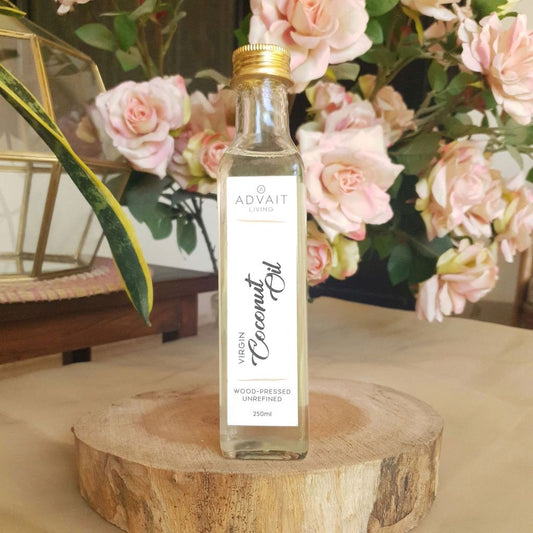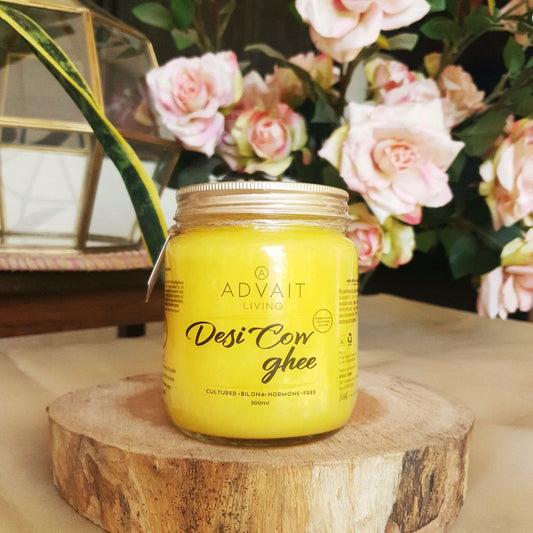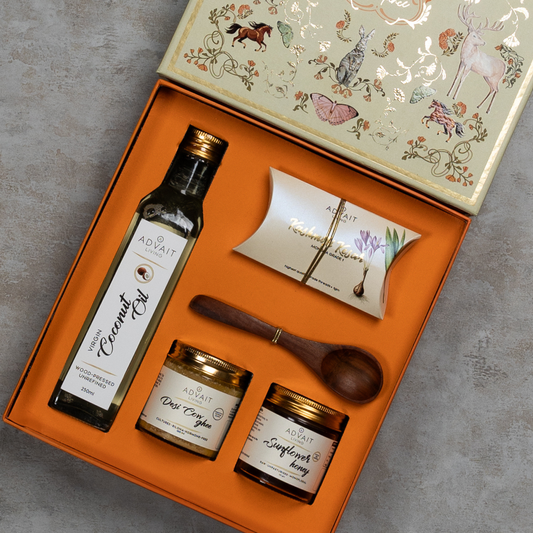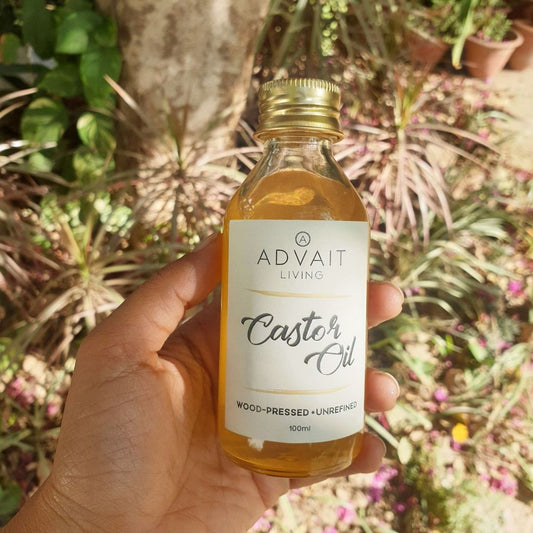An age-old practice rooted in Ayurveda, Gandusha kriya or oil pulling involves swishing oil in the mouth to promote dental health and overall well-being. Join us as we explore the science, benefits, and simple steps to incorporate this traditional technique into your daily routine.
What is Oil Pulling?
Oil pulling has been practised in India for thousands of years based on Ayurvedic techniques of maintaining oral hygiene. In recent times, this practice has surged in popularity, captivating the attention of health enthusiasts and practitioners alike and is fast making a comeback.
Oil pulling is swishing an oil inside the mouth for a few minutes, 5-20 minutes based on the technique, and then spitting it out. It is essentially the same practice as using a mouthwash. The oil absorbs the bacteria in the mouth and slows down the corrosion of teeth.
There is an increasing awareness among the public about chemical ingredients in conventional oral care products and their harmful effects and oil pulling presents a safe, traditional, and natural alternative with no side effects for preventive oral healthcare. The detoxifying properties of oil pulling have further fueled its popularity. The practice's ability to potentially eliminate fat-soluble toxins, including heavy metals, resonates with individuals seeking holistic approaches to mitigate environmental stressors.
How Does Oil Pulling Work?
The process of oil pulling involves swishing a tablespoon of oil in the mouth for about 5-20 minutes. During this time, the oil is claimed to absorb bacterial toxins and reduce the corrosion of tooth surfaces.
The lipid cell membranes of bacteria in the mouth adhere to the oil, facilitating their elimination. The emulsification of the oil helps prevent the deposition of plaque-forming bacteria on teeth and gums, thus averting various oral conditions, including dental caries and gum diseases.
Furthermore, oil pulling provides relief from issues such as dry mouth and bad breath, contributing to overall oral well-being. In incorporating organic, cold-pressed oils into this practice, individuals not only prioritize their dental health but also leverage the nutritional benefits of these oils for a holistic approach to oral care.
Note of Caution: Consulting with a healthcare professional or dentist before starting oil pulling, especially for children, is advisable to ensure it is a safe and suitable practice for individual health conditions.
Why Does Ayurveda Recommend Oil Pulling?
According to Ayurveda, this time-tested therapy is believed to address a spectrum of 30 different diseases, extending beyond oral health concerns.
As elucidated in Charaka Samhita (Chapter V, Pages 78-80), oil pulling is described as,
“It is beneficial for strength of jaws, depth of voice, flabbiness of face, improving gustatory sensation and good taste for food. One used to this practice never gets dryness of throat, nor do his lips ever get cracked; his teeth will never be carious and will be deep rooted; he will not have any toothache nor will his teeth set on edge by sour intake; his teeth can chew even the hardest eatables”.
Oil pulling is also a better choice for cleaning the mouth than using conventional mouthwashes. Most mouthwashes contain alcohol as well as Triclosan, CPC (Cetyl pyridinium chloride) and Chlorhexidine which kills all the bacteria in the mouth, even the good bacteria. We need beneficial bacteria to protect our gut lining. These bacteria help form a solid defence against other microorganisms and are a major part of our immune system.
Coconut oil and sesame oil have a chelating effect on the body. They bind to and pull out fat-soluble toxins like heavy metals & pesticides that accumulate in our bodies. Therefore, oil pulling can be an important detoxifying protocol which is very useful since our environment is becoming increasingly toxic.
Which Oil is Best for Oil Pulling?
Whilst any edible oil can be used for oil pulling, it is recommended that you opt for cold-pressed oils for any self-care routine including oil pulling. Cold pressed oils are safe, naturally extracted, do not have any chemicals or preservatives and do not have any side-effects. It is highly recommended to avoid the use of refined oil for any oil pulling or oral care routine. Here are some oils to consider for your oil pulling routines:
Cold-Pressed Sesame Oil
According to Ayurveda and traditionally cold pressed sesame oil is the best choice for oil pulling due to its nutritional profile. Research indicates that sesame oil has antibacterial effects against certain oral microorganisms.
Sesame oil is also packed with essential nutrients, including vitamin E, linoleic acid, and other essential fatty acids. These nutrients can nourish the gum tissues and help maintain their health and integrity. It is also noted that the root of sesame (Sesamum indicum) contains chlorosesamone which has antifungal activity. And the naturally occurring polyunsaturated fatty acids present in sesame oil may reduce free radical injury occurring in the oral cavity as well.
Cold-Pressed Coconut Oil
Amongst all the cold-pressed oils, virgin coconut oil has become very popular due to its flavour, taste and smell. It is the main reason why people prefer to do oil pulling with it compared to other oils.
Create Your Own Powerful Oil for Oil Pulling
Creating a powerful blended oil, that includes both sesame and coconut oil, is best suited to start an oil-pulling routine. Follow the recipe below to create your own oil blend for oil pulling every day.
Ingredients:
- 1/2 cup cold-pressed sesame oil
- 1/2 cup cold-pressed coconut oil
- 10-12 cloves
Instructions:
Ensure that you select cold-pressed oils only as they are safe and non-toxic. Look for options labelled as cold pressed, wood pressed, unrefined, raw, pure, virgin, and free from additives or chemicals. This guarantees the highest quality for your oil-pulling mixture.
1. Combine Oils:
In a clean glass jar, mix equal portions of cold-pressed sesame oil and coconut oil.
2. Add Cloves for Flavor and Benefits:
Include 10-12 cloves in the oil mixture. Cloves not only contribute to a delightful taste but also bring their antimicrobial properties to enhance the effectiveness of your oil pulling routine.
3. Soak Overnight:
Allow the mixture to sit overnight, letting the flavours meld and the beneficial compounds from the cloves infuse into the oils.
4. Strain for Smoothness:
The next day, strain the mixture using a fine mesh or cheesecloth to remove any solid particles. This ensures a smooth and comfortable experience during oil pulling.
5. Store in a Glass Jar:
Transfer the strained elixir back into the glass jar for convenient use. Glass is preferable over plastic to maintain the purity of the oils and prevent any potential leaching of chemicals.
6. Oil Pulling Routine:
Take a tablespoon of the elixir into your mouth and swish it around for 15-20 minutes. Spit the oil into a trash can (avoid spitting into the sink to prevent clogging) and then rinse your mouth thoroughly with water.
7. Regular Use:
Incorporate oil pulling into your morning oral care regimen. The natural goodness of cold-pressed oils and the added benefits of cloves will leave your mouth feeling refreshed and your oral health revitalized.
How To Oil Pull The Right Way?
For effective oil pulling, blend your own oil (see instructions above) or choose a high-grade, virgin and cold pressed oil for your routine. Cold pressed coconut oil or sesame oil are most recommended. The practice yields optimal benefits when done in the mornings before brushing and consuming breakfast. It is a practice that can be done daily without any harmful side-effects.
To perform oil pulling correctly, sit upright with your chin pointed upwards or you can stand upright during the swishing process to prevent swallowing or aspiration of the oil. There are primarily two ways to do oil pulling or oral cleansing as per Ayurvedic texts:
1. Kavala Graha
Here is how you can practice kavala graha safely:
Procedure:
- Take a spoonful of oil and fill your mouth with it. A tablespoon of oil for adults is recommended and a smaller teaspoon can be used for children over five years.
- Swish the oil around the mouth for about 5-10 minutes and it is crucial not to swallow the oil while swishing and to contain the swishing within the oral cavity, avoiding the throat.
- 'Pull' and force the oil between all teeth by swishing it throughout the mouth.
- When done correctly, the oil should turn into an opaque viscous fluid, having pulled out deposits from the teeth and gums.
Post-Procedure:
- Once done, spit out the oil.
- Rinse the mouth thoroughly with clean warm water.
- Clean teeth with fingers or perform routine tooth brushing to eliminate any residual oil.
Disposal:
- It is best not spit the oil into the basin/sink to avoid pipe clogging.
- Spit the oil into a trashcan or on a paper towel.
2. Gandusha
Ganudsha is another ayurvedic technique for oral cleansing. Here is how you can do it,
- Take a mouthfull of oil and fill your mouth with it.
- Hold the oil in the mouth for 5-15 minutes.
- Unlike kavala graha oil pulling technique, no continuous swishing is required.
- Spit out the oil and rinse the mouth with water.
Note of Caution: It's important to note that oil pulling is not recommended for children below 5 years of age due to the risk of aspiration or swallowing. For children above 5 years, a teaspoon of oil is advised, and adults should supervise the procedure until the child becomes familiar with it.
When To Do Oil Pulling?
Should one do oil pulling before or after meals? Or can oil pulling be done anytime during the day?
As per Ayurvedic texts, oil pulling is best performed right in the morning after waking up and before brushing. It is ideally done on an empty stomach.
Health Benefits of Oil Pulling
Oil pulling is a powerful way to improve overall oral health. Studies and clinical trials demonstrate that consistent practice of oil pulling reduces plaque formation, decreases harmful bacteria, protects teeth and gums from issues like tooth decay, enamel corrosion, and even gum infections.
Ayurveda also recommends the oil therapy as both preventive and a curative technique. Gargling with oil can potentially purify the entire bodily system; as each section of the tongue is connected to different organs such as to the kidneys, lungs, liver, heart, small intestines, stomach, colon, and spine, similarly to reflexology.
Building a consistent oil pulling routine as part of your daily ritual can help you with:
1. Improved Oral Health:
One of the primary health benefits of oil pulling is its positive impact on oral health. Studies demonstrate that regular oil pulling, especially with coconut oil can help reduce plaque formation, gingivitis, and harmful bacteria in the mouth. This, in turn, contributes to healthier teeth and gums, reducing the risk of dental issues such as cavities and gum disease.
2. Fresh Breath:
Research indicates that oil pulling can be effective in combating bad breath. The swishing action of the oil helps to remove bacteria and toxins and prevent plaque or calculus formation that can contribute to unpleasant odours.
3. Reduced Risk of Gum Inflammation:
Some studies show that oil pulling may reduce gum inflammation. The antimicrobial properties of coconut oil can help control the growth of bacteria that contribute to gum inflammation, making it a potential preventive measure against more serious periodontal issues.
4. Potential Systemic Benefits:
While the evidence is not conclusive, the process is claimed to aid in detoxification, improve metabolism, and contribute to the overall well-being of the body. However, more research is needed to substantiate these broader health claims.
5. Natural Teeth Whitening:
Oil pulling is often praised for its teeth-whitening effects. The process helps remove surface stains on teeth, leading to a brighter and whiter smile over time. While it may not replace professional teeth-whitening treatments, oil pulling offers a natural and gradual approach to maintaining a brighter dental appearance.
Note of Caution: It's essential to note that while many individuals report positive outcomes from oil pulling, scientific studies supporting some of these claims are limited, and individual experiences may vary. It's always advisable to complement oil pulling with regular dental care practices, such as brushing, flossing, and professional dental check-ups, for comprehensive oral health.
Conclusion
In conclusion, we recommend oil pulling as a valuable addition to oral care routines, provided patients are willing and able to follow the instructions accurately. When executed correctly with organic, cold-pressed oils like coconut or sesame oil, oil pulling has shown remarkable benefits, including reduced plaque, gingivitis, and harmful bacteria in the mouth.
- Oils to use: Only non-toxic, safe, natural and cold pressed oils must be used for oil pulling for enhanced oral hygiene and care.
- Frequency: Practice oil pulling daily. For enhanced healing benefits, it can be practised up to three times a day on an empty stomach before meals as well from time-to-time.
- Timing: Ideally performed daily in the morning and on an empty stomach before brushing teeth.
- Precaution: Avoid swallowing or inhaling the oil, especially during vigorous oil pulling to avoid ingesting bacteria and toxins.
- Position: Best practised standing or in a seated position with the chin held up.
- Contraindications: Not recommended for children below 5 years due to the risk of aspiration.
We believe that oil pulling is a personalized choice that, when embraced conscientiously, can be a transformative and beneficial practice for those seeking a natural and effective means of enhancing their oral well-being.
Frequently Asked Questions
1. What is oil pulling?
Oil pulling involves swishing coconut oil in the mouth to remove bacteria, toxins, and plaque, promoting improved oral hygiene and fresher breath.
2. Which oil is good for oil pulling?
Organic, cold-pressed oils like coconut or sesame oil are recommended for oil pulling due to their rich nutrient structure.
3. Do dentists recommend oil pulling?
While some dentists acknowledge its potential benefits, published research evidence is inconclusive, and opinions on recommending oil pulling may vary among dental professionals.
4. Do I brush after oil pulling?
Yes, it's advisable to brush your teeth after oil pulling to ensure complete oral hygiene.
5. Who should avoid oil pulling?
Individuals prone to allergies to specific oils or those with difficulty following instructions, such as young children, should avoid oil pulling. Also, asthma patients are advised to avoid oil pulling to not trigger breathing issues accidentally by inhaling the oil.
6. Are there negatives to oil pulling?
Incorrect practices may lead to aspiration, jaw fatigue, and gastrointestinal discomfort. It's crucial to follow proper guidelines.
7. Is it okay to oil pull every day?
Yes, oil pulling can be done daily as part of a comprehensive oral care routine, provided it is done correctly.
8. Should I oil pull daily?
If done correctly and consistently, daily oil pulling can contribute to improved oral health and hygiene. However, it is not mandatory to be followed every day. Once or twice a week is still effective.
9. Can oil pulling stop tooth decay?
While it may aid in preventing tooth decay, oil pulling is not a cure for existing decay. Professional dental care is essential for treating decayed teeth.
10. Can I drink water after oil pulling?
Yes, you can drink water after oil pulling. It's recommended to brush your teeth and rinse your mouth thoroughly to remove any residual oil before consuming liquids.


























